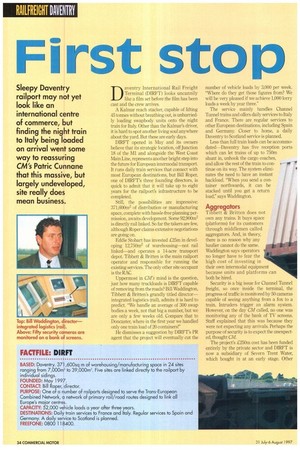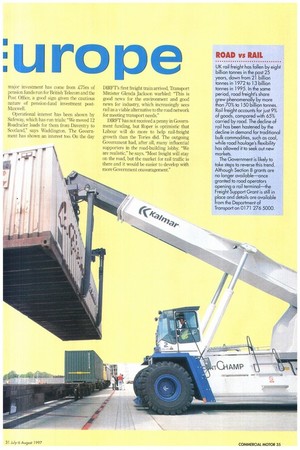, ;rsiA• sto
Page 36

Page 37

If you've noticed an error in this article please click here to report it so we can fix it.
urn
Daventry International Rail Freight Terminal (MUT) looks uncannily like a film set before the film has been cast and the crew arrives.
A Kalmar reach stacker, capable of lifting 45 tonnes without breathing out, is unhurriedly loading swapbody units onto the night train for Italy. Other than the Kalmar's driver, it is hard to spot another living soul anywhere about the yard. But these are early days.
DIRFT opened in May and its owners believe that its strategic location, off Junction 18 of the M1 and alongside the West Coast Main Line, represents another bright step into the future for European intermodal transport. It runs daily train services that connect with most European destinations, but Bill Roper, one of DIRFT's three founding directors, is quick to admit that it will take up to eight years for the railport's infrastructure to be completed.
Still, the possibilities are impressive: 371,600m2 of distribution or manufacturing space, complete with hassle-free planning permission, awaits development. Some 92,900m2 is directly rail linked. So far the takers are feN,v, although Roper claims extensive negotiations are going on.
Eddie Stobart has invested £25m in developing 12,750m2 of warehousing—not rail linked—and operates a 14-acre transport depot. Tibbett & Britten is the main railport operator and responsible for running the existing services. The only other site occupant is the RAC.
Uppermost in CM's mind is the question, just how many truckloads is DIRFT capable of removing from the roads? Bill Waddington. Tibbett & Britten's grandly titled director— integrated logistics (rail), admits it is hard to predict. "We handle an average of 300 swap bodies a week, not that big a number, but we are only a few weeks old. Compare that to Doncaster, where in the first year we handled only one train load of 20 containers!"
He dismisses a suggestion by DIRFF's PR agent that the project will eventually cut the number of vehicle loads by 3,000 per week. "Where do they get those figures from? We will be very pleased if we achieve 1,000 lorry loads a week by year three."
The service mainly handles Channel Tunnel trains and offers daily services to Italy and France. There are regular services to other European destinations, including Spain and Germany. Closer to home, a daily Daventry to Scotland service is planned.
Less than full train loads can be accommodated—Daventry has five reception ports which can let trains of up to 750m
shunt in, unhook the cargo coaches,
and allow the rest of the train to conEN 11 tinue on its way. The system elimi nates the need to have an instant backload. "When you send a container northwards, it can be stacked until you get a return load," says Waddington.
Aggregators Tibbett & Britten does not own any trains. It buys space (platforms) for its customers through middlemen called aggregators. And, in theory, there is no reason why any haulier cannot do the same. Waddington says operators no longer have to fear the high cost of investing in their own intermodal equipment because units and platforms can both be hired.
Security is a big issue for Channel Tunnel freight, so once inside the terminal, the progress of traffic is monitored by 50 cameras capable of seeing anything from a fox to a train. Intruders trigger an alarm system. However, on the day CM called, no one was monitoring any of the bank of TV screens. Staff explained that this was because they were not expecting any arrivals. Perhaps the purpose of security is to expect the unexpected, thought CM.
The project's <£250m cost has been funded entirely by the private sector and DIRFT is now a subsidiary of Severn Trent Water, which bought in at an early stage. Other major investment has come fi-om L75m of pension funds run for British Telecom and the Post Office, a good sign given the cautious nature of pension-fund investment postMaxwell.
Operational interest has been shown by Safeway, which has run trials: "We moved 12 Roadrailer loads for them from Daventry to Scotland," says Waddington. The Government has shown an interest too. On the thy
DIRFT's first freight train arrived, Transport Minister Glenda Jackson warbled: "This is good news for the environment and good news for industry, which increasingly sees rail as a viable alternative to the road network for meeting transport needs."
D1RFt has not received a penny in Government funding, but Roper is optimistic that Labour will do more to help rail-freight growth than the Tories did. The outgoing Government had, after all, many influential supporters in the road-building lobby. "We are realistic," he says. "Most freight will stay on the road, but the market for rail traffic is there and it would be easier to develop with more Government encouragement."




































































































